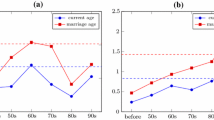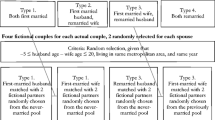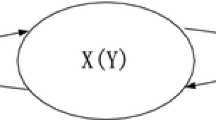Abstract
The term ‘marriage market’ refers to the application of economic theory to the analysis of the process that determines how men and women are matched to each other through marriage and how this process influences other choices including human capital investment and the allocation of marital surplus. The specific sub-topics in this article include a characterization of stable assignment in marriage, consideration of the effects of marriage allocations on distribution within marriage, discussion of the extent to which partners who marry have similar characteristics, and a review of results on marriage timing.
Access provided by CONRICYT-eBooks. Download reference work entry PDF
Similar content being viewed by others
Keywords
- Assortative mating
- Dowries
- Fertility
- Human capital investment
- Inequality
- Marriage markets
- Non-market production
- Stable assignment
- Transferable utility
JEL Classifications
The marriage market is a term used by economists to characterize the process that determines how men and women are matched to each other through marriage. Formally the marriage market may be thought of as an allocative process that, given the preferences and endowments of two sets of individuals (men and women), yields a set of couples and unmatched individuals and a distribution of resources within each match. Marriage markets are generally distinguished from other sorting processes such as worker–firm matching by the assumption that each member of each set of individuals is matched to at most one member of the other set. However, the basic concept of the marriage market may also be applied to other cases such as polygamy or same-sex partnerships. It is also generally assumed that one’s well-being within marriage is determined by the characteristics of one’s partner and the distribution of resources within the marriage, but not the matches of other individuals in the marriage market conditional on these factors. The economics literature on the marriage market has built importantly on a two-part foundational article on the economics of marriage published in 1973 and 1974 (Becker, 1973, 1974). However, the phrase ‘marriage market’ is considerably older, with a first citation in the Oxford English Dictionary of 1842.
Stable Assignment
Central to the notion of a marriage market is the notion of stable assignment. A stable assignment may be characterized as a set of partner allocations and distributions of resources within marriage so that no individual of one sex would be willing to make an offer (in terms of partnership and a distribution of resources within that partnership) to an individual of the other sex which that individual strictly prefers to his or her equilibrium allocation.
An early and important divide in terms of economic models of marriage arises with respect to the question of transferable utility. Transferable utility arises when well-being within the household may be freely transferred between members of the household through a reallocation of household resources. Under these conditions the question of who marries whom can be importantly separated from the question of how resources are distributed within marriage and any stable marriage assignment can be characterized as the outcome of the maximization of a linear programme (Bergstrom, 1997).
At the other extreme from a transferable utility model is one in which there is no possibility of transferring resources within or across marriage. A key feature of such models is that there is generally a wide variety of possible stable equilibria. Gale and Shapley (1962) illustrate two such stable equilibria, by the construction of two matching algorithms based on who makes offers and who makes the decision to accept, tentatively accept, or reject those offers. Each man is at least as well off in the equilibrium in which men make offers relative to the equilibrium in which women makes offers and vice versa.
Distributive Effects
Becker’s (1973) pioneering analysis of the marriage market considered, among other things, the effects of the marriage market on household distribution. Consider, for example, a simplified version of this model in which there is heterogeneity in tastes for being single, transferable utility within marriage, and no heterogeneity across couples in total utility within marriage. The outcome of the model is a distribution parameter that characterizes the share of total marital utility going to each partner within marriage and a number of marriages, with those individuals of both sexes with the highest taste for being single remaining unmarried. Among other things the model illustrates how a rise in the female wage raises the utility of married females within marriage even when married women are not active in the labour market. The increased opportunities for women outside marriage implies that women must, at the margin, receive a higher share of marital utility in order to be willing to marry.
There is substantial debate about the importance of marriage market structure in influencing transfers between partners and their respective households of origin at the time of marriage. Of particular relevance is the evidence of a historical transition from bride-price to dowry in parts of South Asia and the very large levels of dowry relative to annual income that are sometimes observed in that region. A number of factors have been argued to play an important role in this regard, including changes in the relative sizes of female and male populations of marriageable age associated with population growth and the gap in typical ages at marriage, changes in inequality and economic opportunity, and changes in the relative merits of different forms of parental transfers in their children.
Assortative Mating
A second issue that has received significant theoretical and empirical scrutiny is the question of the extent to which the marriage market matches men and women with similar characteristics. This issue is thought to be important because of its implications for interhousehold inequality and for intergenerational transmission of inequality. If high-earning men match with high-earning women, and these high-earning couples transfer these resources to their children in the form of financial assistance and/or human capital, then inequality is likely to be more persistent across generations than would be the case otherwise. Assortative mating by religion and/or immigrant status is also thought to be both an indicator of and contributor to the process of assimilation. Finally, assortative mating on unobservable (to analysts) attributes can affect inferences about household behaviour that condition on household composition. For example, if men with a high unobservable taste for child human capital match with more educated women, then highly educated women will appear to have more educated children even if there is no direct effect.
A simple transferable utility model in which marital output is increasing in the product of male and female quality yields the prediction that there should be positive assortative mating on such attributes as intelligence, wealth and beauty. A possible exception arises with respect to market earnings capacity to the extent that, as postulated by Becker (1973), one member of the couple specializes in the production of non-market goods. Interestingly, the theoretical prediction of positive assortative mating across classes of individuals can arise within the marriage market with imperfect information (Burdett and Coles, 1997).
The evidence supports the prediction of positive assertive mating on partner attributes, although there have been changes over time in the degree to which this is observed. In particular, the degree of educational assortative mating fell between 1940 and 1960 in the United States but has increased subsequently, largely due to a decline in the share of low-education individuals marrying (Schwartz and Mare, 2005). There has also been a shift in the sign of the correlation in partner earnings from negative to positive since the 1960s (Schwartz, 2005), a pattern that has contributed to the overall increase in interhousehold inequality in income.
Marriage Timing
A third set of marriage-market issues relates to the timing of marriage, particularly for women. It is argued that early marriage can result in higher fertility, lower rates of human capital investment, and an adverse bargaining position from the perspective of women. Boulier and Rosenzweig (1984), in an early contribution on this subject, showed how unobserved attractiveness could lead to incorrect inference about the role of education in delaying marriage and increasing spousal quality. Bergstrom and Bagnoli (1993) show how the process of uncertainty resolution with regard to the marital prospects may differentially affect the timing of marriage for men and women of different qualities. It also is the case that timing of marriage can play an important role in the equilibration of marriage markets given substantial differences in the relative numbers of eligible men and women arising from sex differences in mortality or a gap in the age at marriage for men and women for a growing population. In particular, because of how changes in the timing of marriage for sequential cohorts of eligible men and women affect the number of marriages taking place at a particular point in time, a persistent ten per cent excess in the number of eligible females relative to males can be accommodated with an increase in the female relative to male age at marriage by just one year over a decade (Foster et al. 2004).
Bibliography
Becker, G.S. 1973. A theory of marriage: Part I. Journal of Political Economy 81: 813–846.
Becker, G.S. 1974. A theory of marriage: Part II. Journal of Political Economy 82: S11–S26.
Bergstrom, T. 1997. A survey of theories of the family. In Handbook of population and family economics, ed. M.R. Rosenzweig and O. Stark, Vol. 1A. New York: North-Holland.
Bergstrom, T.C., and M. Bagnoli. 1993. Courtship as a waiting game. Journal of Political Economy 101: 185–202.
Boulier, B., and M. Rosenzweig. 1984. Schooling, search and spouse selection: Testing economic theories of marriage and household behavior. Journal of Political Economy 92: 712–732.
Burdett, K., and M. Coles. 1997. Marriage and class. Quarterly Journal of Economics 112: 141–168.
Foster, A., N. Khan, and A. Protik. 2004. Equilibrating the marriage market in a rapidly growing population: Evidence from rural Bangladesh. Working paper, Department of Economics, Brown University.
Gale, D., and L. Shapley. 1962. College admissions and the stability of marriage. American Mathematical Monthly 69: 9–15.
Schwartz, C.R. 2005. Earnings inequality among married couples and the increasing association between spouses’ earnings. Working paper, Department of Economics, UCLA.
Schwartz, C.R., and R.D. Mare. 2005. Trends in educational assortative marriage from 1940 to 2003. Demography 42: 621–646.
Author information
Authors and Affiliations
Editor information
Copyright information
© 2018 Macmillan Publishers Ltd.
About this entry
Cite this entry
Foster, A. (2018). Marriage Markets. In: The New Palgrave Dictionary of Economics. Palgrave Macmillan, London. https://doi.org/10.1057/978-1-349-95189-5_2637
Download citation
DOI: https://doi.org/10.1057/978-1-349-95189-5_2637
Published:
Publisher Name: Palgrave Macmillan, London
Print ISBN: 978-1-349-95188-8
Online ISBN: 978-1-349-95189-5
eBook Packages: Economics and FinanceReference Module Humanities and Social SciencesReference Module Business, Economics and Social Sciences




